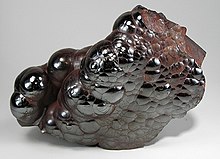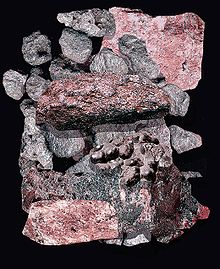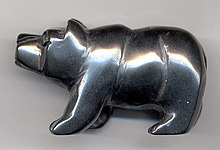Hematite
| Hematite | |
|---|---|
| Hematite in two forms as a fine crystalline crystal lawn (right) and a kidney aggregate (bottom left) with quartz (top left), size: 15.0 × 11.1 × 7.9 cm | |
| General and classification | |
| other names |
|
| chemical formula | Fe 2 O 3 |
|
Mineral class (and possibly department) |
Oxides and hydroxides - oxides with metal: oxygen = 2: 3 |
|
System no. to Strunz and to Dana |
4.CB.05 ( 8th edition : IV / C.04) 04.03.01.02 |
| Similar minerals | Goethite , lepidolite , ilmenite |
| Crystallographic Data | |
| Crystal system | trigonal |
| Crystal class ; symbol | ditrigonal-scalenohedral; 3 2 / m |
| Space group | R 3 c (No. 167) |
| Lattice parameters | a = 5.03 Å ; c = 13.75 Å |
| Formula units | Z = 6 |
| Frequent crystal faces | {10 1 1}, {10 1 2}, {0001}, less often {10 1 8}, {11 2 3}, {01 1 4}, {01 1 1}, {11 2 0} |
| Twinning | Twin laws according to {0001} and {10 1 2}; Pressure twin lamellae according to {10 1 2} |
| Physical Properties | |
| Mohs hardness | 5 to 6 (VHN 100 = 1000 to 1100) |
| Density (g / cm 3 ) | measured: 5.26; calculated: 5.255 |
| Cleavage | no |
| Break ; Tenacity | uneven to slightly scalloped; brittle, elastic only in thin platelets |
| colour | steel-gray to black, red-brown, tinged with different colors, weathering red |
| Line color | cherry red to red brown |
| transparency | opaque, translucent edges |
| shine | Metal gloss, matt |
| magnetism | weak when heated |
| Crystal optics | |
| Refractive indices |
n ω = 3.150 to 3.220 n ε = 2.870 to 2.940 |
| Birefringence | δ = 0.280; strong dispersion |
| Optical character | uniaxial negative |
| Pleochroism | Dichroism, yellow-red-brown-red |
| Other properties | |
| Chemical behavior | poorly soluble in hydrochloric acid (HCl) |
Hematite or blood stone , also known as iron luster , specularite , red iron stone and red iron ore , is a very common mineral from the mineral class of oxides (and hydroxides) with the empirical formula Fe 2 O 3 and the most common naturally occurring modification of iron (III) oxide .
Hematite crystallizes in the trigonal crystal system and develops various pyramidal, cube-like, rhombohedral or tabular to columnar crystal forms that can reach a size of several centimeters. In addition, it also occurs in the form of coarse, grape-like and rosette-shaped to radial-radial mineral aggregates . Fresh samples are steel gray to black in color and have a strong metallic sheen . Over time, however, the mineral surfaces can tarnish or take on a dull red color due to weathering.
Together with clay and chalk, hematite is part of the pigment red chalk .
Etymology and history
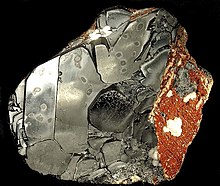
The name hematite is derived from the ancient Greek αἷμα haima "blood, bloodshed, blood relatives" (genitive: αἵματος haimatos ), the etymology of which is unclear.
The synonym Blutstein for Roteisen varieties has been documented in the German-speaking area since the 15th century. The common synonym bloodstone (translated "blood stone") in English-speaking countries stands for the heliotrope (German synonym "blood jasper") and is therefore a misleading false friend .
The now outdated designation specularite (= "mirror stone") indicates that hematite was polished and used as a mirror in ancient times due to its strong metallic sheen.
The Rötelabbau was one of the earliest mining activities of mankind; the powdery mineral was already used 164,000 ± 12,000 years ago in Pinnacle-Point in South Africa . Hematite powder can also be found in graves that are around 80,000 years old. In Rydno in Poland and in Lovas in Hungary are Paleolithic Rötelgruben known (60,000 v. Chr.).
The oldest underground mines in Europe are located in Tzines and Vaftochili on the Greek island of Thasos (around 15,000 to 20,000 BC). In Germany you can also find traces of prehistoric mining near Bad Sulzburg and in the Münstertal (Black Forest) with a comparable extent from around 5000 BC. BC, which can be assigned to the ceramic band culture on the Upper Rhine.
The Assyrians obtained hematite ( NA 4 KA.GI.NA, šadanu) from the Nairi countries in north-eastern Turkey, among others . It is documented as a tribute under Tiglat-pileser I.
The rich deposits of iron luster on the island of Elba were already mined by the Etruscans .
In the Fichtelgebirge in northeast Bavaria, mining on hematite was documented from 1300.
classification
Already in the outdated, but partly still in use 8th edition of the mineral classification according to Strunz , the hematite belonged to the mineral class of "oxides and hydroxides" and there to the department of "oxides with the molar ratio of metal: oxygen = 2: 3", where it was named the "hematite group" with the system no. IV / C.04 and the other members eskolaite , karelianite and corundum .
The 9th edition of Strunz's mineral systematics , which has been in effect since 2001 and is used by the International Mineralogical Association (IMA), classifies hematite in the expanded section of "Oxides with the molar ratio of metal: oxygen = 2: 3, 3: 5 and comparable" . This is further subdivided according to the relative size of the cations involved , so that the mineral can be found according to its composition in the sub-section “With medium-sized cations”, where it can be found together with auroantimonate , brizziite , corundum, ecandrewsite , eskolaite, geikielite , ilmenite , karelianite , Melanostibite , pyrophanite and romanite the "corundum group" with the system no. 4.CB.05 forms.
The systematics of minerals according to Dana , which is mainly used in the English-speaking world , assigns hematite to the class of "oxides and hydroxides" and there into the "oxides" category. Here it is together with corundum, eskolaite, karelianite and tistarite in the " corundum-hematite group (rhombohedral: R-3c) " with the system no. 04.03.01 to be found in the subsection “Simple oxides with a cation charge of 3+ (A 2 O 3 )”.
Crystal structure
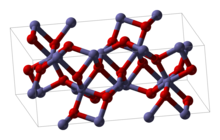
Hematite crystallizes in the so-called "corundum structure:", i.e. H. isotype with corundum in the trigonal crystal system in the space group R 3 c (space group no. 167) with the lattice parameters a = 5.03 Å and c = 13.75 Å and 6 formula units per unit cell .
The crystal structure can be described as a slightly distorted hexagonal closest packing of oxygen atoms, with only every sixth oxygen layer on top of each other. The Fe 3+ cations sit in the octahedron gaps , although only 2/3 of these gaps are occupied, which means a lowering of symmetry in the trigonal system.
properties
Hematite is usually opaque and only reddish translucent in very thin flakes. After a while it becomes variegated and turns red due to weathering. The line color is usually a characteristic blood red; the name of the mineral is derived from it and from the blood-red colored grinding water during processing.
Its Mohs hardness is between 5 and 6 and its density is measured on average 5.26 g / cm³. However, due to small amounts of magnesium and titanium and other elements, which vary depending on the location , the density can fluctuate between 5.2 and 5.3 g / cm³.
Hematite is antiferromagnetic . Its Néel temperature is 675 ° C.
In front of the soldering tube , hematite is infusible and is only slowly soluble in acids, even when powdered.
Modifications and varieties

The compound Fe 2 O 3 is dimorphic and occurs naturally in addition to the trigonal hematite as a cubic crystallizing maghemite .
With ilmenite hematite forms an uninterrupted at temperatures above 950 ° C mixed batch . On cooling, however, the mixed crystals disintegrate and lamellar ilmenite is formed.
Hematite occurs in different training variants , but crystallizes mostly as hematite in steel gray to iron black, shiny metal, often iridescent crystals or blätterigschuppigen crystals as micaceous iron oxide or Eisenrahm .
So far the following varieties of hematite are known:
- Blood stone : completely dense red iron ore in the Ore Mountains, not to be confused with heliotrope
- Iron mica , iron cream : finely flaky
- Iron ocher , red ocher or red chalk : mixed with clay and therefore soft
- Iron rose : rosette-shaped crystal aggregate
- Minette ore : oolithic- sedimentary
- Red glass head : with a neat surface and a fibrous structure
As Martite one is Pseudomorphose of hematite to magnetite referred.
Education and Locations


Hematite occurs both in sedimentary deposits and as a gangue mineral . He is responsible for the red color of many rocks - a significant example are the banded iron ore formation from the era of the Archean . Besides magnetite , pyrite and rutile , accompanying minerals are also ilmenite , goethite , siderite and, in sediments, lepidocrocite . Well-known giant deposits of this type include the Krywyj-Rih iron ore basin (German Krivoi Rog or Kriwoi Rog ) in the Ukraine (formerly USSR), Minas Gerais in Brazil and the area around Lake Superior and the Mesabi Range in the USA.
Red sediments, which were formed in a dry, warm (arid) climate, contain hematite as well as iron ore or itabirite. Vein-shaped hematite deposits were formed by the precipitation of free iron III ions dissolved in water on open fissures and fissures in these rocks. They contain the various forms of hematite: red iron cream, red iron mica, red iron luster, red iron ocher, red glass head, blood stone, red chalk and many more.
The corridors of Suhl in the Thuringian Forest , which were already mined in the Middle Ages, were particularly pure hematite deposits . The veins run in latite and rhyolite (porphyrite and porphyry) and show only quartz , limestone, fluoro and barite as veins , but no phosphorus and sulfur minerals. The ores could therefore be used for the extraction of soft iron for the barrel forge.
Other well-known vein deposits are in Siegerland (North Rhine-Westphalia) and near Wölsendorf (Bavaria) in Germany, near Mitterberg ( St. Johann im Pongau ) in Austria and Kutimsk in the Urals in Russia.
Hematite is less common in carbonate rocks. In some cases it forms a cement , for example in a few reef limestone in the Lahn-Mulde , but also in crevices in the former Kuhwald diabass quarry in Rachelshausen (Marburg-Biedenkopf district).
Other iron ores such as magnetite , limonite or iron spar often occur with hematite . The gangue consists mainly of calcite , dolomite , quartz or clay and the impurities are mostly pyrite and apatite .
As a widespread mineral formation, hematite can be found at very many sites around the world, with almost 14,000 sites being known to date (as of 2015).
Hematite was also found in mineral samples from the seabed of the Mid-Atlantic Ridge , the Central Indian Ridge and the Pacific Ocean (including the Bismarck Sea ) and in the Red Sea .
Outside the Earth, hematite was detected by the Opportunity and Spirit probes on Mars , more precisely in the Gale Crater and Gusev Crater in the Aeolis quadrangle region and in the Eagle , Endurance and Victoria craters in the Terra Meridiani region. The hematite finds are considered evidence of water resources on this planet.
use
As a raw material
In its pure state, hematite contains 70 percent iron and is the most important iron ore alongside magnetite (72 percent iron).
In addition, hematite is used as a polishing agent; the crystalline form of the hematite was also used as a mirror for a long time because of its high reflectivity.
For corrosion protection , hematite in the form of fine, flat, crystalline platelets in a paint matrix is used as a top coat on hot-dip galvanized steel parts. Corrosion protection can last up to 25 years and more if exposed to the elements. Use among other things for lanterns, bridges and power poles.
As a pigment
Hematite is an important and non-toxic pigment . Already in the Paleolithic it was used for cave paintings and body painting; today it is used by the Himba in Namibia for personal hygiene.
Hematite is often pressed for use in the arts. The pressed rods are untreated or used as pencil leads. Red chalk pencils are soft, color well and are used by artists for drawing and sketching. Important artists' colors are, for example, red bolus , a variety with a high clay content, which is mainly used as a base material for gilding , ocher , Pompeian red , English red , Venetian red , Terra di Pozzuoli and the violet-tinged caput mortuum .
The pigment is also suitable for painting ceramics and for dyeing knotted threads for carpets .
In analog photography , red chalk is used for retouching large-format negatives and positives , as it dries up to be opaque and can be washed off again.
As a gem
Hematite is a popular gemstone that is noticeable after polishing with its strong metallic sheen. It is used on the one hand in a faceted shape or as a cabochon for jewelry goods, but on the other hand it is also made into small sculptures .
It should be noted, however, that hematite is very sensitive to heat, salts and acids (especially borax and boric acid). B. can be rapidly decomposed when worn on the skin. In addition, it breaks easily due to its brittleness.
Several manipulations and imitations of the hematite are available in jewelry stores. The available under the trade designation hematin or Hematine is a "reconstruction" of powdered and sintered iron oxide. According to CIBJO, reconstructed hematite must be designated as such. A rock from Brazil, which consists of hematite and magnetite , on the other hand, may be offered as hematite as long as the hematite content is higher than 50%. In contrast to pure hematite, this rock, despite its identical appearance, has a granular structure, has a brown-black line and is also magnetic. A simple compass test is sufficient as proof.
Due to the optical similarity, hematite can be confused with davidite (radioactive!), Cassiterite , neptunite , pyrolusite (in the case of massive formation) and wolframite , and these are also occasionally processed into gemstones, although usually only for collectors.
Legendary healing powers and protective spells
Already in ancient Egypt and Babylon , hematite was used as jewelry and amulet in the form of small figures of gods or gems or cylinder seals with incised depictions of scenes from the world of the gods.
From esoteric Hematite is a healing stone , especially in diseases of the blood used, where he held various positive effects on the blood and the formation of blood should have. In addition, it is considered a healing and protective stone for hemophiliacs . B. should work against the formation of bruises. However, according to the esotericists, it should not be used for inflammation . Furthermore, it belongs to the root chakra in Tantric Hinduism . Otherwise it should avert misfortune and negative influences and bring luck. It should also help to open up hidden power reserves. However, there is no scientific evidence of its effectiveness.
Hematite or blood stone is assigned as a planet stone according to Uyldert (1983) to Pluto and according to Raphaell (1987) or Richardson and Huett (1989) to Mars . As a protective stone, depending on the source, it is assigned to the zodiac sign Aries or Scorpio .
See also
literature
- Hans Lüschen: The names of the stones. The mineral kingdom in the mirror of language . 2nd Edition. Ott Verlag, Thun 1979, ISBN 3-7225-6265-1 , p. 235 .
- WE Tröger, U. Bambauer, F. Taborsky, HD Trochim: Optical determination of rock-forming minerals . Part 1: Determination tables . Schweizerbarth, Stuttgart 1981, ISBN 3-510-65106-5 .
- Ch. Chrysanthaki-Koukouli, Gerhard Weissgerber: Prehistoric Ocher Mines on Thasos . In: Ch. Koukouli-Chrysanthaki, A. Muller, St. Papadopoulos (eds.): Thasos. Matières premières et technology de la préhistoire à nos jours. Actes du Colloque International 1995 . tape 26-29 . De Boccard, Paris 1999, ISBN 2-86958-141-6 , pp. 129-144 .
- Petr Korbel, Milan Novák: Mineral Encyclopedia (= Villager Nature ). Nebel Verlag, Eggolsheim 2002, ISBN 978-3-89555-076-8 , p. 84 .
- Josef Paul Kreperat: Precious stones and minerals - healing powers - application - properties . Kosmos Verlag, Stuttgart 2003, ISBN 3-440-09230-5 .
Web links
- Mineralienatlas: Hematite and Mineralienatlas: Mineralienportrait / Hematit (Wiki)
- Hematite at mineralienwissen.de
- Gert Goldenberg: Neolithic hematite mining in the southern Black Forest (individual subject areas in the respective subdirectory)
- The Suhl iron ore mining
- Gemstone etiquette - hematite as a gemstone
- Webmineral - Hematite
- atabase-of-Raman-spectroscopy - Hematite
- American-Mineralogist-Crystal-Structure-Database - Hematite
Individual evidence
- ^ A b c Hugo Strunz , Ernest H. Nickel : Strunz Mineralogical Tables. Chemical-structural Mineral Classification System . 9th edition. E. Schweizerbart'sche Verlagbuchhandlung (Nägele and Obermiller), Stuttgart 2001, ISBN 3-510-65188-X , p. 193 .
- ^ A b Helmut Schrätze , Karl-Ludwig Weiner : Mineralogie. A textbook on a systematic basis . de Gruyter, Berlin; New York 1981, ISBN 3-11-006823-0 , pp. 394 .
- ↑ a b c Hematite . In: John W. Anthony, Richard A. Bideaux, Kenneth W. Bladh, Monte C. Nichols (Eds.): Handbook of Mineralogy, Mineralogical Society of America . 2001 ( handbookofmineralogy.org [PDF; 68 kB ]).
- ↑ a b c Mindat - Hematite
- ↑ Dieter Lehmann: Two medical prescription books of the 15th century from the Upper Rhine (= Würzburg medical historical research . Volume 34 ). Part I: Text and Glossary. Horst Wellm, Pattensen / Han. 1985, ISBN 3-921456-63-0 , pp. 160 .
- ^ Walter Schumann: Precious stones and gemstones. All kinds and varieties. 1900 unique pieces . 16th revised edition. BLV Verlag, Munich 2014, ISBN 978-3-8354-1171-5 , pp. 178 .
- ↑ A. Ruppenthal: Hematite (blood stone). ( Memento from April 30, 2015 in the Internet Archive ) In: The world of precious stones (PDF; 181 kB)
- ↑ Curtis W. Marean include: Early human use of marine resources and pigment in South Africa during the Middle Pleistocene . In: Nature . tape 449 , 2007, pp. 905–908 , doi : 10.1038 / nature06204 .
- ↑ Betina Faist : The long-distance trade of the Assyrian Empire between the 14th and 11th centuries BC (= Old Orient and Old Testament . Volume 265 ). Ugarit Verlag, Münster 2001, ISBN 3-927120-79-0 , p. 43 .
- ^ Friedrich Müller: Fichtelgebirge - Bavaria's rich corner . 2nd Edition. Upper Franconian Publishing House u. Druckerei, Hof 1984, ISBN 3-921615-24-0 .
- ↑ Walter Borchardt-Ott: Crystallography. An introduction for scientists . 6th, revised and expanded edition. Springer, Berlin [a. a.] 2002, ISBN 3-540-43964-1 , pp. 264 .
- ↑ a b c Hans Jürgen Rösler : Textbook of Mineralogy . 4th revised and expanded edition. German publishing house for basic industry (VEB), Leipzig 1987, ISBN 3-342-00288-3 , p. 382-384 .
- ↑ a b Friedrich Klockmann : Klockmanns textbook of mineralogy . Ed .: Paul Ramdohr , Hugo Strunz . 16th edition. Enke, Stuttgart 1978, ISBN 3-432-82986-8 , pp. 513-515 (first edition: 1891).
- ↑ Martin Okrusch, Siegfried Matthes: Mineralogie. An introduction to special mineralogy, petrology and geology . 7th, completely revised and updated edition. Springer, Berlin [a. a.] 2005, ISBN 3-540-23812-3 , pp. 54 .
- ↑ Mindat - Number of localities for hematite
- ↑ a b List of locations for hematite in the Mineralienatlas and Mindat
- ↑ astronews - Opportunity finds hematite
- ↑ Science @ home - Spirit discovers hematite
- ↑ Bernhard brother embellished stones. Recognizing imitations and manipulations in gemstones and minerals . Neue Erde Verlag, 2005, ISBN 978-3-89060-079-6 , pp. 70 .
- ^ Walter Schumann: Precious stones and gemstones. All kinds and varieties. 1900 unique pieces . 16th, revised edition. BLV Verlag, Munich 2014, ISBN 978-3-8354-1171-5 , pp. 178, 200, 228, 230, 232 .
- ↑ Simone Michel : The magical gems . Akademie Verlag, 2004, ISBN 3-05-003849-7 , pp. 170-171 .
- ↑ Christian Eder : The Egyptian motifs in the glyptic of the eastern Mediterranean at the beginning of the 2nd millennium. v. Chr. Peeters Publishers & Department of Oriental Studies, 1995, ISBN 90-6831-775-X .
- ↑ a b Heilstein Guide - Hematite
- ^ Walter Schumann: Precious stones and gemstones. All kinds and varieties. 1900 unique pieces . 16th revised edition. BLV Verlag, Munich 2014, ISBN 978-3-8354-1171-5 , pp. 283 ff .


